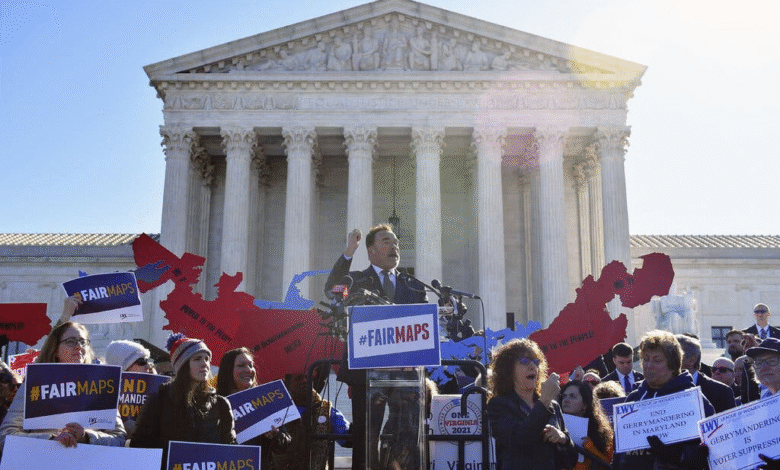California Gerrymandering: Voters to Decide New Map

California gerrymandering is set to take center stage as voters face a critical decision this fall regarding a newly proposed Democratic-drawn congressional map. Recent legislation, championed by Democratic Gov. Gavin Newsom, aims to reshape the state’s electoral landscape ahead of the impending 2026 election. This move follows Texas’ controversial redistricting effort, which seeks to solidify more Republican congressional seats, raising the stakes for both parties as they prepare for a tightly contested battle for control of Congress. The legislative measures, passed by California’s Democratic-controlled Assembly and Senate, could allow Democrats to gain crucial ground by counteracting GOP advantages in states like Texas. As anticipation builds, Californians must weigh the implications of this gerrymandering plan on their political representation and the broader electoral dynamics in the country.
The ongoing debate surrounding California’s electoral districting is a vivid example of political maneuvering inherent in the legislative process. As state officials push for a rearrangement of California’s congressional boundaries, this initiative echoes the broader challenges faced in redistricting across the nation. With the 2026 electoral race looming, the situation mirrors other states grappling with partisan redistricting, particularly the recent shifts seen in Texas. Advocates for the new Democratic map argue it serves as a necessary response to opposing efforts by Republicans, while critics emphasize the potential undermining of independent electoral commissions established to ensure fair representation. This high-stakes scenario reflects the intricate relationship between state politics and national electoral strategies.
Understanding California Gerrymandering
California gerrymandering has emerged as a critical topic, especially with the recent legislative moves by the state’s Democratic-controlled Legislature. The process involves manipulating the boundaries of electoral districts to benefit one political party over another. Following the passage of a new congressional map drawn by California Democrats, voters are now set to head to the polls to decide whether to accept these proposed changes. This decision follows the state’s independent redistricting commission, which was originally intended to handle such matters devoid of political influence.
The implications of this gerrymandering are multifaceted, affecting not only local political dynamics but also the broader balance of power in Congress. Analysts indicate that the proposed map could help Democrats secure up to five additional congressional seats in the upcoming 2026 election. This could potentially alter the trajectory of House races and enable the party to counter the Republican gains anticipated from Texas’s recent redistricting efforts. As California approaches this pivotal election, the stakes surrounding legislative fairness and party dominance are at an all-time high.
Impact of Democratic Redistricting in California
The recent push for a Democratic-drawn congressional map in California is not just a local issue but part of a broader strategy in anticipation of the 2026 election. By creating revitalized electoral boundaries, California Democrats aim to fortify their position against the backdrop of Texas’s aggressive Republican gerrymandering, which could yield significant advantages for the GOP. The need for urgent action stems from the reality that control of Congress is at stake, making California’s decision pivotal for both parties.
Governor Gavin Newsom and his allies argue that the restructuring of district lines is essential for political equity, especially in light of the perceived injustices brought by Texas’s new map. With heavy financial backing from Democratic super PACs, the campaign to support this ballot measure is gaining momentum, indicating strong party solidarity. The outcome of this redistricting debate will likely shape not just California’s political landscape but could also resonate nationally, influencing how election strategies are orchestrated across the United States.
The Role of Gov. Gavin Newsom in Redistricting
As the driving force behind the Democratic redistricting plan, Gov. Gavin Newsom has positioned himself as a key player in California’s electoral strategy. His support for the recent legislation underscores his commitment to enhancing Democratic representation in the face of Republican maneuvers in states like Texas. By signing the bill into law, Newsom aligns California’s political interests with a broader national narrative of partisanship and electoral control.
Newsom’s efforts reflect a strategic counteraction to Republican gains, particularly those projected from Texas’s congressional map revisions. His administration has mobilized significant resources for campaigning, revealing a substantial commitment to this cause. The implications of his leadership extend beyond California’s borders, as the state’s congressional composition could influence nationwide voting patterns, potentially impacted by changes in the balance of power following the 2026 elections.
California vs. Texas: A Redistricting Battle
The clash between California and Texas over congressional maps highlights the intense political rivalry that characterizes modern American politics. As California Democrats prepare to counteract the gerrymandering strategies employed by Texas Republicans, the implications are profound for electoral competition in the 2026 election. Analysts suggest that the ongoing struggle over congressional seats reflects a larger trend of partisan redistricting that may define the future of legislative control in Congress.
As both states draw their boundaries, the impacts extend beyond their respective borders, influencing national party strategies and voter mobilization efforts. This rivalry not only amplifies the urgency of addressing gerrymandering but also underscores the need for transparency and fairness in the electoral process. Ultimately, the outcomes in California and Texas will set precedents that could affect gerrymandering practices nationwide.
Potential Consequences of Gerrymandering
The consequences of gerrymandering extend far beyond immediate electoral outcomes, deeply influencing political representation and public trust in the democratic process. If California’s proposed congressional map is approved, it could lead to significant shifts in the distribution of power within Congress, allowing Democrats to secure an edge in key elections. This potential for gaining seats raises concerns about fair representation and whether the electorate’s will is genuinely reflected in the outcomes.
Furthermore, gerrymandering often exacerbates partisan divisions, creating districts that are drawn to favor one party while marginalizing the representation of others. In California’s competitive political landscape, the ramifications of these decisions will likely reverberate through electoral cycles, prompting discussions about fair districting practices. The challenge for California voters lies in understanding not just the immediate impact of these gerrymandered lines but also their long-term implications for political integrity.
Public Response to Redistricting Efforts
The public reaction to the proposed Democratic gerrymandering in California has been mixed, reflecting a deep concern over electoral integrity and fair representation. Advocacy groups and citizens alike have raised alarms regarding the perceived manipulation of district lines for partisan gain, emphasizing the importance of maintaining the independent redistricting commission originally established to ensure objectivity. As voter sentiment grows, initiatives seeking to uphold transparency and fairness in the electoral process are likely to gain traction.
Additionally, polling data indicates that while many Californians support the Democratic party’s intentions, there is notable skepticism about circumventing the established redistricting commission. This public discourse is critical as it shapes the narrative leading up to the upcoming vote. The outcome may serve as a referendum on not just redistricting practices in California, but also the standards by which Americans expect their electoral processes to function.
Funding the Redistricting Campaign
The financial backing for the campaign supporting California’s Democratic-drawn congressional map is significant, indicating a coordinated effort by party leaders to foster electoral success. Governor Gavin Newsom’s disclosure of millions in funding from both local and national party sources highlights the seriousness of this initiative. By securing substantial resources from Democratic super PACs, the campaign positions itself to maximize outreach and voter engagement ahead of the pivotal ballot measure.
This financial influx plays a crucial role in shaping the narrative around redistricting, allowing campaigners to effectively counter Republican criticisms. The ability to mobilize resources can substantially influence public opinion and voter turnout, particularly in an election cycle that is expected to be fiercely contested. Consequently, the dynamics of funding in California’s redistricting campaign not only reflect immediate political strategies but also the long-term aspirations of the Democratic Party as they prepare for the 2026 elections.
Legal Challenges to Redistricting Plans
As with any political maneuver, legal challenges likely loom over the proposed Democratic congressional map in California. Historical precedents illustrate how gerrymandered maps have often faced scrutiny in courts, where legal battles can ensue over claims of partisan bias and unfair representation. Observers anticipate that if California voters approve the new map, it may soon be tested in legal arenas, reflecting broader national trends concerning redistricting disputes.
These potential legal challenges could shape the implementation of the new districts, influencing how they are perceived by the public and their eventual functionality in elections. Furthermore, the outcomes of such legal battles may serve as landmark rulings that set important precedents for future redistricting efforts both in California and beyond. The interplay between political ambitions and legal frameworks will be critical in determining the fate of the proposed congressional map.
Bipartisan Implications of Redistricting
The implications of California’s congressional redistricting extend beyond party lines, posing potential consequences for bipartisan relations. While Democrat-led efforts aim to fortify their positions, they may inadvertently fuel Republican sentiments about gerrymandering practices, promoting calls for reform across both political spectrums. If the California map results in significant electoral victories for Democrats, it could provoke a politicized backlash from Republicans at both the state and national levels.
As the debate surrounding gerrymandering intensifies, it highlights the necessity for bipartisan dialogue on redistricting reforms that foster fair electoral practices. Ultimately, the fallout from California’s decision may inspire collaborative efforts to redefine how congressional maps are drawn, addressing the pervasive issue of partisan influence. By embracing a more equitable approach, there lies the potential to bridge divides and restore public trust in electoral processes as California navigates this contentious landscape.
Frequently Asked Questions
How does California gerrymandering affect the congressional map for the 2026 election?
California gerrymandering, specifically through the newly proposed Democratic-drawn congressional map, aims to reshape electoral districts ahead of the pivotal 2026 election. This redistricting effort seeks to counteract Republican gains from Texas, potentially allowing Democrats to secure up to five additional congressional seats in California.
What role does Gov. Gavin Newsom play in California’s gerrymandering efforts?
Gov. Gavin Newsom is a key proponent of California’s gerrymandering efforts, having signed legislation that allows the Democratic-controlled Legislature to propose a new congressional map. This map is intended to offset Republican gains in Texas, showcasing Newsom’s strategy to strengthen Democratic representation ahead of the 2026 election.
What is the significance of California’s independent redistricting commission in the gerrymandering debate?
California’s independent redistricting commission was established to prevent partisan gerrymandering. However, the recent push for a Democratic-drawn congressional map seeks to bypass this commission, highlighting a contentious debate on balancing political power and fair representation as voters head to the polls for the special election.
How will the new California congressional map impact Democratic redistricting efforts?
If approved, the new California congressional map will bolster Democratic redistricting efforts by potentially allowing the party to gain up to five additional congressional seats in the 2026 election, acting as a strategic response to Republican redistricting gains in Texas.
Are there any financial contributions related to California’s gerrymandering efforts?
Yes, significant financial contributions have been made to support the gerrymandering efforts in California. For instance, Gov. Gavin Newsom’s political committee disclosed $2 million in donations, alongside $3 million from a national Democratic super PAC focused on House races, underscoring the high stakes of the upcoming election.
What criticisms are there regarding California’s gerrymandering initiative?
Critics of California’s gerrymandering initiative argue that it undermines the original intent of the independent redistricting commission designed to ensure fair and impartial districting. Additionally, Republicans have accused Democratic leaders of politicizing the redistricting process to gain an electoral advantage, especially in light of recent developments in Texas.
What potential outcomes could arise from California’s decision on the congressional map?
The outcome of California’s decision on the congressional map could significantly impact the balance of power in Congress. Approval of the Democratic-drawn map could lead to increased Democratic representation by gaining seats, while a rejection would maintain the status quo under the independent redistricting commission.
How does California’s congressional gerrymandering relate to national political dynamics?
California’s congressional gerrymandering reflects broader national political dynamics as both parties maneuver to secure control for upcoming elections. The proposed changes are seen as a direct counter to Texas Republicans’ redistricting efforts, demonstrating the interconnectedness of state-level decisions and national electoral strategies.
| Key Point | Details |
|---|---|
| Legislation Passed | California’s Democratic Legislature passed redistricting bills on August 22, 2025. |
| Special Election | Voters will decide on the new congressional map in a special election this fall. |
| Counteraction to Texas | The plan aims to counter Texas Republicans’ newly drawn map intended to gain additional Republican seats. |
| Redistricting Commission | Voters may temporarily bypass California’s independent redistricting commission. |
| Potential Benefits for Democrats | The new maps could potentially allow Democrats to gain five additional seats in the House. |
| Campaign Support | The ballot measure received significant financial support from Governor Newsom and national Democrats. |
Summary
California gerrymandering is a pivotal issue as voters prepare to cast their ballots on a new Democratic-drawn congressional map this fall. With the goal of countering Texas’ Republican map and enhancing Democratic representation, this potential redistricting marks a significant moment in the political landscape ahead of the 2026 elections. The outcome not only influences state dynamics but also holds implications for the broader congressional balance of power.



